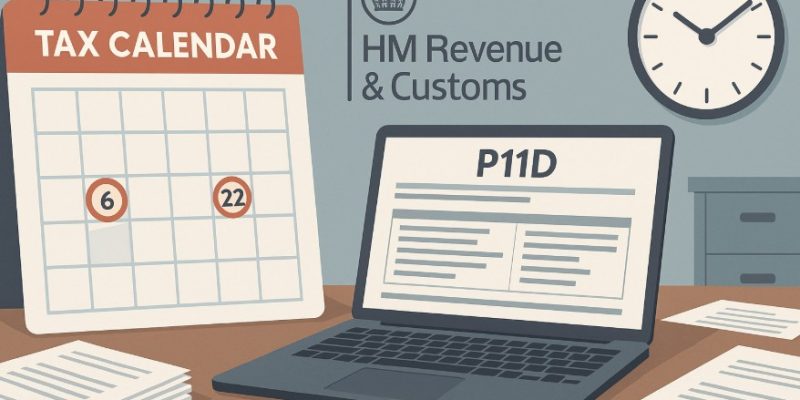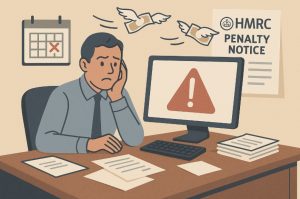
When Do P11Ds Need to Be Submitted to HMRC? | Deadlines You Must Know
Managing employee benefits in the UK comes with its own set of responsibilities, one of the most important being the submission of P11D forms.
If you’re an employer or payroll administrator, knowing when P11Ds need to be submitted is essential to avoid penalties and maintain HMRC compliance.
In this blog, we explore key deadlines, reporting requirements, and expert tips to help you file accurately and on time.
What Is a P11D and Why Is It Important for Employers?

The P11D is a form used by UK employers to report taxable benefits in kind that have been provided to employees or directors during a tax year.
These are non-cash benefits that hold monetary value and need to be disclosed to HMRC so that accurate tax assessments can be made.
The benefits reported on a P11D enable HMRC to update an employee’s tax code for the following year and verify their overall tax position.
These forms also play a key role in the calculation of Class 1A National Insurance Contributions, which are payable by the employer.
Examples of reportable benefits include:
- Company cars and fuel
- Private medical insurance
- Low or no-interest loans exceeding £10,000
- Employer-paid personal bills or subscriptions
- Accommodation provided to employees
- Club memberships for personal use
If an employer chooses to payroll certain benefits, they do not need to report those items on a P11D. However, a P11D(b) is still required to account for the related National Insurance liabilities.
When Exactly Do P11Ds Need to Be Submitted to HMRC?
Employers must submit P11D and P11D(b) forms by 6 July following the end of the relevant tax year.
The associated Class 1A NICs must be paid by 22 July if paying electronically, or by 19 July if sending payment by post.
This timeline ensures that tax records can be updated promptly and that employee tax codes reflect the benefits received during the previous tax year.
The table below outlines the relevant deadlines for the three current tax years:
| Tax Year | Deadline for P11D Submission | Deadline for Class 1A NIC Payment |
| 2023/24 | 6 July 2024 | 22 July 2024 |
| 2024/25 | 6 July 2025 | 22 July 2025 |
| 2025/26 | 6 July 2026 | 22 July 2026 |
It is essential to note that from March 2023 onwards, HMRC no longer accepts paper forms. All P11D and P11D(b) submissions must be made online using either the HMRC PAYE Online system or compatible payroll software.
What Is the Difference Between P11D and P11D(b)?

The P11D and P11D(b) serve different but related purposes in the reporting process. The P11D is submitted for each employee or director who received taxable benefits.
The P11D(b), on the other hand, is used by the employer to calculate and report the Class 1A National Insurance Contributions due on the total benefits provided.
Employers are required to complete a P11D(b) if:
- They submit any P11Ds
- They have payrolled benefits
- HMRC has requested a return, even if no benefits were provided
Both forms must be submitted together where applicable to ensure full compliance with year-end employer responsibilities.
Who Needs to Submit a P11D Form?
P11Ds must be submitted for all employees and directors who received taxable benefits during the tax year. However, there are situations where no P11D is needed:
- If the employer has registered with HMRC to payroll all benefits
- If the benefits fall under the trivial benefit exemption
- If no benefits were provided at all
It is still necessary to file a P11D(b) to account for Class 1A NICs, even when benefits are payrolled or no P11Ds are filed.
Errors commonly arise when employers forget to include directors or incorrectly assume that certain low-value benefits are exempt.
How Do You Submit a P11D to HMRC?
Submitting P11D forms to HMRC is now a fully digital process. Employers are responsible for ensuring the forms are completed accurately and submitted on time.
Errors or missed submissions can result in penalties, so understanding the process is crucial.
Methods for Submitting P11Ds
Employers have two primary options for submitting P11Ds and P11D(b)s:
Using HMRC’s PAYE Online Service
HMRC’s PAYE Online portal provides a direct method for smaller businesses or those with fewer employees. Employers must:
- Log in with their Government Gateway account
- Complete and submit forms using HMRC’s online tools
- Retain submission confirmations for records
This method is straightforward but may be less efficient for employers dealing with large numbers of P11Ds.
Using Commercial Payroll Software
Most businesses use approved commercial payroll or accounting software to complete and submit forms electronically. These systems often:
- Integrate with internal payroll data
- Automatically calculate Class 1A NICs
- Generate employee copies of P11Ds
Using such software reduces the risk of manual errors and ensures that submissions meet HMRC formatting standards.
Required Information for Submission
Before filing, employers should gather and verify the following information:
- Employee details including NI numbers and job titles
- Details of benefits provided and their valuation
- Dates when benefits were made available
- Any amounts paid back by employees
Having accurate records ensures correct reporting and reduces the likelihood of needing amendments later.
Providing Employee Copies
Employers must also ensure that each affected employee receives a copy of their P11D by 6 July. This allows them to:
- Check the accuracy of reported benefits
- Complete their self-assessment tax return if required
- Raise queries before HMRC updates their tax codes
Best Practices for Smooth Submission
- Validate all figures before submission
- Double-check employee identifiers
- Maintain an internal audit trail
- Use deadline reminders to ensure timely action
Employers are also encouraged to run internal benefit reviews quarterly or semi-annually to catch errors early.
What Happens If You Miss the P11D Submission Deadline?

Missing the 6 July deadline can result in financial penalties. HMRC charges a monthly penalty of £100 per 50 employees for each month or part month the return is late. Interest is also charged on any unpaid Class 1A National Insurance.
In addition to penalties, late or incorrect submissions may trigger a compliance check from HMRC.
This can lead to further scrutiny and administrative effort for the business.
Employers who identify errors or missed submissions should act quickly to correct them and notify HMRC to mitigate penalties.
Amended forms can be submitted electronically, and Class 1A NICs should be paid immediately upon discovery of underpayment.
What Employee Benefits Need to Be Reported on a P11D?
Not all benefits provided to employees need to be reported on a P11D. However, those that carry taxable value and are not exempt or payrolled must be disclosed.
Common Reportable Benefits
The most frequent types of reportable benefits include:
- Company cars provided for personal use
- Fuel cards or allowances for private motoring
- Private medical insurance or dental coverage
- Employer-provided loans over £10,000
- Accommodation or housing allowance
- Assets made available for personal use such as holiday homes, boats, or classic cars
- Non-cash vouchers or gifts above exemption thresholds
These benefits must be valued correctly and entered into the corresponding section on the P11D form.
Benefits That May Be Exempt from Reporting
Certain benefits are specifically excluded from P11D reporting, provided they meet qualifying conditions. These include:
- Trivial benefits (each costing £50 or less and meeting all exemption criteria)
- Annual staff events not exceeding £150 per person
- Work-related training
- Mobile phones, provided only one is given and it is not part of a salary sacrifice arrangement
- Business travel expenses that meet HMRC rules
Even exempt benefits require careful documentation in case of HMRC audit.
Payrolling vs P11D Reporting
Employers who choose to payroll benefits include the value of those benefits in an employee’s monthly or weekly pay, so they are taxed in real time.
These benefits do not need to be included on a P11D form but still need to be included in the P11D(b) to account for NICs.
To payroll benefits, employers must register with HMRC before the start of the tax year in which they intend to payroll.
Benefits typically payrolled include:
- Company cars and fuel
- Medical insurance
- Gym memberships
- Loans and accommodation
Once payrolled, these are excluded from P11D but still subject to Class 1A NICs.
Valuing Employee Benefits
Accurate benefit valuation is crucial for compliant reporting. Valuations may vary depending on the benefit type. For example:
- Company cars are calculated using the car’s list price, CO2 emissions, and fuel type
- Accommodation values depend on cost, market rental value, and associated expenses
- Assets like holiday homes are calculated as 20% of market value unless unavailable for private use during part of the year
Valuation guidance is provided by HMRC, and employers should consult their tax advisor or software provider for accurate calculation methods.
Overview of Reportable and Exempt Benefits
| Benefit Type | Reportable on P11D | Conditions for Exemption |
| Company car with personal use | Yes | Exempt only if payrolled |
| Private medical insurance | Yes | No general exemption |
| Loan over £10,000 | Yes | Only reportable if no interest or low interest |
| Staff party under £150 per head | No | Must be annual and open to all staff |
| Mobile phone (one per employee) | No | Not part of salary sacrifice |
| Trivial gifts under £50 | No | Must meet all exemption criteria |
| Assets like holiday homes or boats | Yes | Special valuation method required |
Employers should review all benefits against HMRC guidance at the end of each tax year to ensure proper classification.
How Can You Ensure Compliance with P11D Reporting Requirements?

To maintain full compliance with HMRC reporting rules, employers should develop a consistent internal process for monitoring, recording, and reporting benefits in kind.
Key practices include:
- Setting up monthly benefit tracking to avoid year-end backlog
- Training payroll and HR teams on what qualifies as a reportable benefit
- Conducting pre-submission audits to catch errors early
- Staying informed of HMRC updates and regulatory changes
Employers should also be cautious with less common benefits, such as luxury assets or director perks. These often attract attention during audits and require detailed documentation and valuation.
How Does the P11D Tie Into Year-End Payroll Responsibilities?
The P11D process is an integral part of the employer’s year-end payroll duties. It links with other reporting obligations such as P60s, final FPS (Full Payment Submission), and EPS (Employer Payment Summary).
To complete the year-end process accurately:
- Ensure all P60s are distributed to employees by 31 May
- Finalise benefit valuations for P11Ds by 6 July
- Submit P11D(b) alongside P11Ds
- Pay Class 1A NICs by 22 July
Employers should maintain a checklist that includes P11D preparation, internal reviews, form distribution, and NIC calculations.
Why Should Employers Stay Updated on HMRC Rules for P11Ds?

HMRC frequently updates its rules around employee benefits and their reporting.
One major change coming into effect is the mandatory payrolling of all benefits starting from the 2026/27 tax year. From that point onwards, P11Ds will no longer be required.
Recent changes include:
- The withdrawal of paper submissions
- Expansion of OpRA (Optional Remuneration Arrangements) rules
- Adjustments to what qualifies under trivial benefit exemptions
Employers must monitor HMRC announcements and adapt their internal processes accordingly.
This includes reviewing existing salary sacrifice arrangements, benefit packages, and payroll configurations.
Conclusion
Filing P11Ds is a legal obligation with strict deadlines. As HMRC moves towards greater digitisation and real-time tax updates, employers must adapt and ensure accurate, timely submissions.
Whether you manage a small team or large workforce, being proactive with your P11D process can save money, prevent penalties, and keep your tax affairs in perfect order.
FAQs About P11D Submission Deadlines and Requirements
What is the penalty for not submitting a P11D on time?
HMRC charges £100 per 50 employees for each full or part month your P11D is late, plus interest on unpaid Class 1A NICs.
Do I need to give a copy of the P11D to the employee?
Yes, each employee must receive a copy of their P11D by 6 July to help them check their tax position and complete their self-assessment if applicable.
Can I amend a P11D after submission?
Yes, if you discover an error, you can submit an amended form electronically. Inform HMRC promptly to minimise any penalties.
What benefits are classed as ‘trivial’ and exempt from reporting?
Benefits costing £50 or less that are not cash or cash vouchers and meet four specific conditions are considered trivial and do not need reporting.
How do I report luxury asset use on a P11D?
Use Box L for “Assets made available without transfer.” Apply the 20% market value rule and account for days the asset is unavailable for private use.
What’s the difference between a P11D and a P60?
A P11D reports non-cash benefits, while a P60 shows an employee’s total PAYE income and tax for the year.
When will payrolling all benefits become mandatory?
From the 2026/27 tax year, all benefits must be payrolled. P11Ds will no longer be used after that point.





